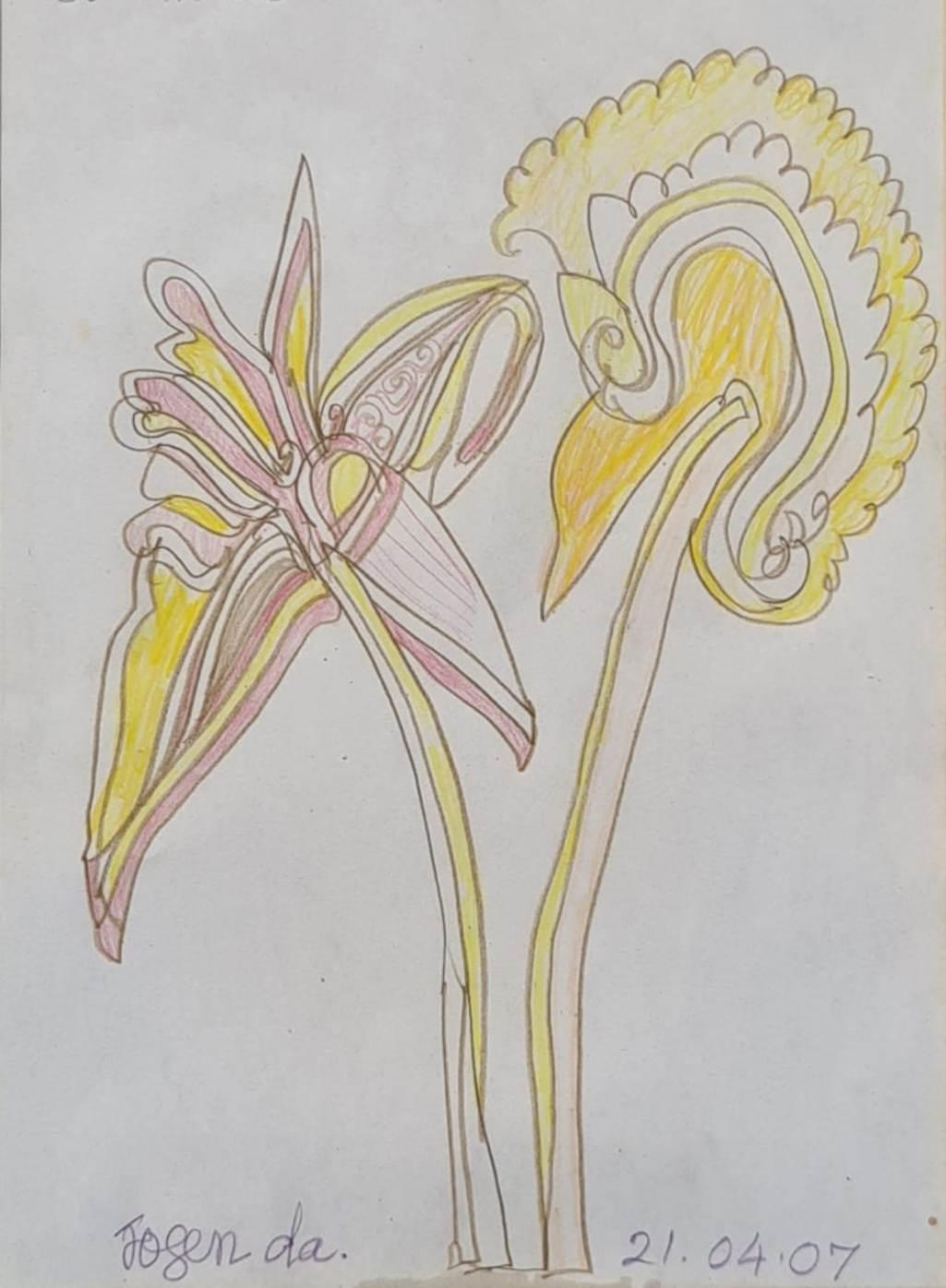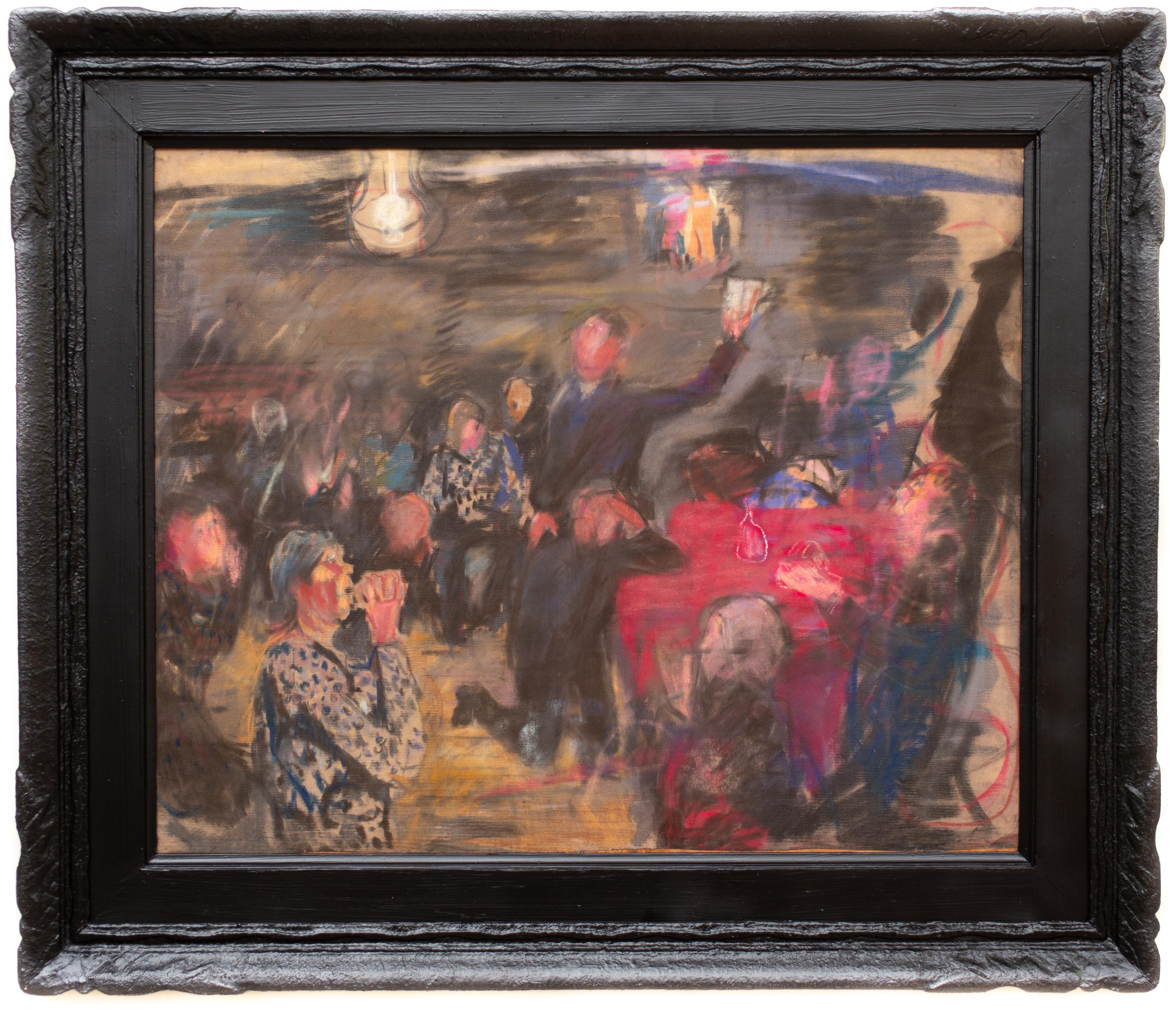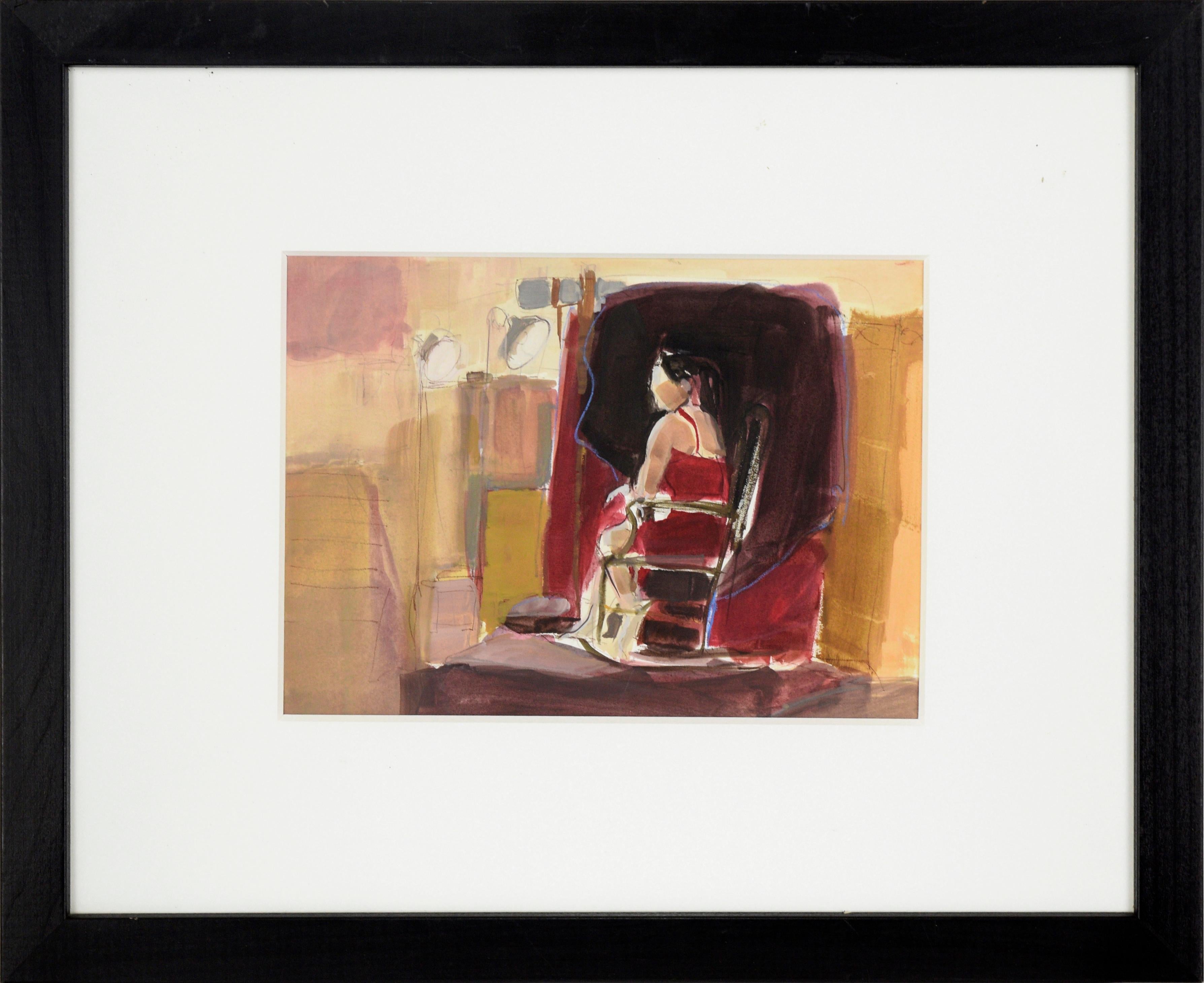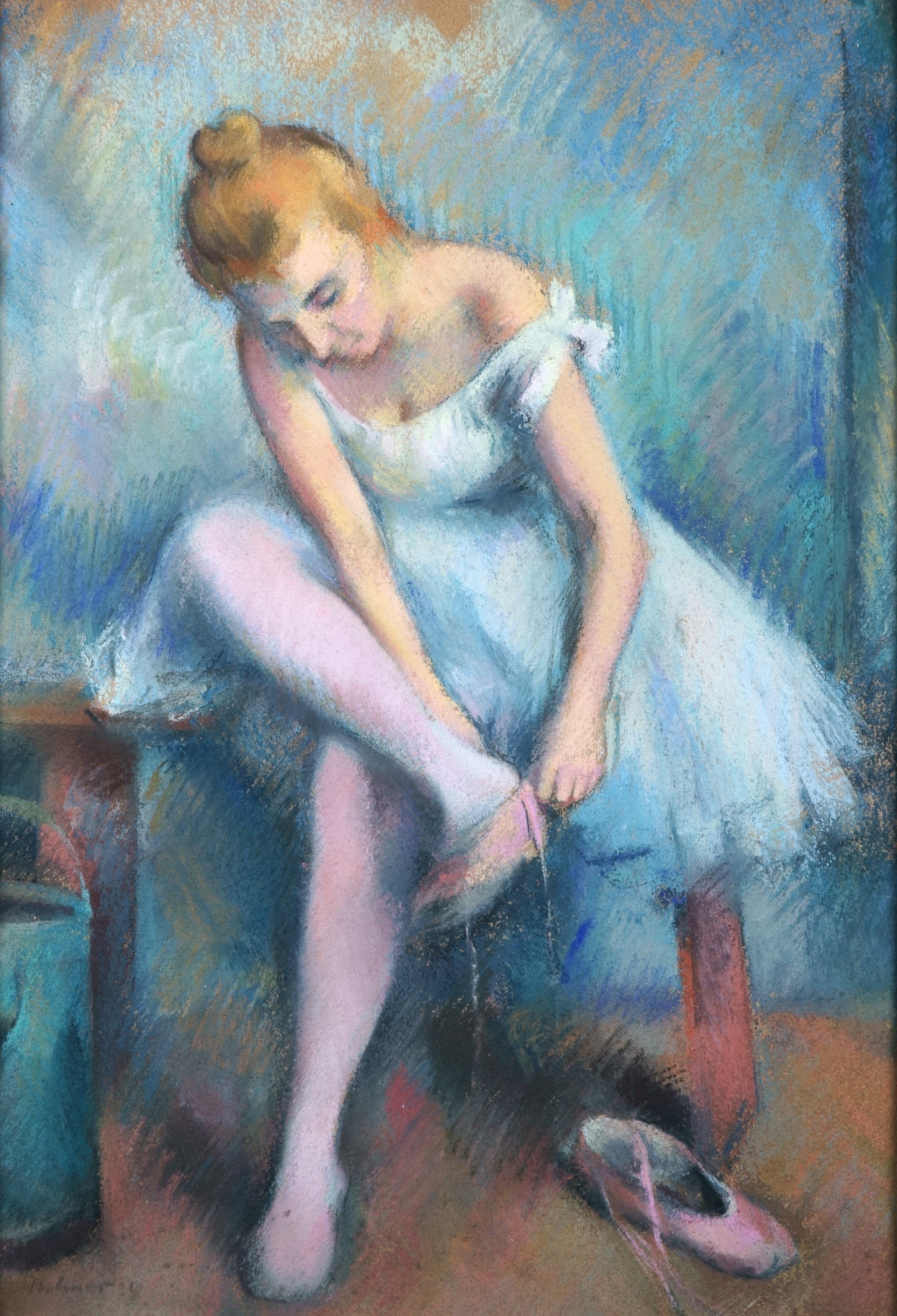Items Similar to Face, Large Eyes, Pastel on Board, Violet, Blue, Brown by Indian Artist"In Stock"
Want more images or videos?
Request additional images or videos from the seller
1 of 11
Prokash KarmakarFace, Large Eyes, Pastel on Board, Violet, Blue, Brown by Indian Artist"In Stock"1996
1996
About the Item
Prakash Karmakar - Untitled - 20 x 29 inches ( unframed size )
Pastel on Board
Inclusive of shipment in roll form
This work is amongst the more rarer work by the artist executed.
About his work :
Large fish-shaped eyes are assets of Prakash Karmakar females by which he is often recalled. More so because his female are rendered askew with voluptuous curves, drunken stare and sometimes wantonly explicit erotic gestures. At one time, quite early in his life his demonic damsels, femmes fatales, or nudes with fleshy shapes of sensual bulge or dismembered limbs or focused genitalia became his signature images. His landscapes too with their piquant painterly refashioning of natural forms and by sheer force of their varied recurrence are currently a fresh subject-index of his style.
Style : Legendary master artist Lt. Prokash Karmakar from Bengal was solely responsible for the Bengal Movement of Art. His father Lt. Prahalad Karmakar was a very famous legendary artist ; but unfortunately all his paintings got burned in the riot. Prokash Karmakar led a very tough life , often sleeping on the platforms of the railway stations of Bengal. Later he worked in the textile line and simultaneously painted and exhibited his works on his own strength , until he got huge acclaim and success .
Prakash Karmakar is considered a revolutionary in the sense that he doesn’t exhibit in art galleries. All through his artistic career he has always exhibited on street corners because he did not want his paintings to be imprisoned within four walls. Most of his earlier artworks capture remembrances from the past – some of them are very personal, and some are from the darkest moments of human history. More recently he has painted landscapes, depicting lush tropical vegetation, hills and valleys, seascapes and mangroves in their wild diversity which have made him even more popular with art galleries.
About the Artist and his work :
Born : Prakash Karmakar was born (1933-2014) in Calcutta.
Education :
Govt. college of Art & craft, Kolkata
Prokash Karmakar came from an artistic family; his father was a renowned artist of his time.
Unfortunately, all of his father's paintings were destroyed in the Hindu Muslim riots in the 1940s, which also ruined his family.
By 1949, both his parents had passed away, forcing him to abandon his studies at the Government College of Arts and Crafts, Kolkata.
He joined the army for two years and then quit to work as a graphic design manager for a medical firm in Kolkata.
Virtually penniless and desperate for a break, in 1956, he held a street exhibition, the first in the city, hanging his works along a corner.
Selected Exhibitions :
2008 - 'Hues of Bengal',Janues Art Gallery
2008 - 'Art from Bengal',Art Elements Gallery,New Delhi
2008 - ‘The Artecurate ‘, Mumbai Art Festival.
2007 - 'Signatures Images',Gallery Kolkata,Kolkata
2007 - ‘Uninterrupted Journeys’, Nitanjali Art Gallery,New Delhi
2007 - ‘Tales of Textures’, Art Elements Gallery,New Delhi
2006 - ‘Drawing show an act of Art –II’,Priyasri Art Gallery,Mumbai
2006 - 'Frames & Beyond',Neheru Center,Mumbai
1968-65-67 - National Art Exhibition, at Lalit Kala Academy, New Delhi
Awards :
2000 - He was a recipient of Abinendra Puraskar Award
1976 - Awards from Biria Academy of Art and Culture, Kolkata
1970 - Rabindra Bharati University, Kolkata.
1969-70 - Fellowship for Study in France.
- Creator:Prokash Karmakar (1933, Indian)
- Creation Year:1996
- Dimensions:Height: 28 in (71.12 cm)Width: 37 in (93.98 cm)Depth: 1 in (2.54 cm)
- Medium:
- Movement & Style:
- Period:
- Condition:
- Gallery Location:Kolkata, IN
- Reference Number:1stDibs: LU60432159463
About the Seller
4.9
Vetted Seller
These experienced sellers undergo a comprehensive evaluation by our team of in-house experts.
Established in 2004
1stDibs seller since 2017
119 sales on 1stDibs
Typical response time: 23 hours
- ShippingRetrieving quote...Ships From: Kolkata, India
- Return PolicyA return for this item may be initiated within 7 days of delivery.
More From This SellerView All
- Untitled, Pastel & Ink on Paper by Modern Indian Artist “In Stock”By Jogen ChowdhuryLocated in Kolkata, West BengalJogen Chowdhury : Untitled Pastel & Ink on Paper ; 11 x 8 inches ; 2007 Signed by the Artist. ( Framed and delivered ) Style : He has immense contribution in inspiring young artists...Category
2010s Modern Figurative Paintings
MaterialsPaper, Pastel, Ink
- Christ, Charcoal & Pastel on Canvas, Black by Contemporary Artist "In Stock"By Bratin KhanLocated in Kolkata, West BengalBratin Khan - Christ Charcoal & Pastel on Canvas, 30 x 24 inches, 2009 The anecdotes and narratives of Krishna's life are generally titled as Krishna Leela. He is a central character in the Mahabharata, the Bhagavata Purana and the Bhagavad Gita, and is mentioned in many Hindu philosophical, theological, and mythological texts. They portray him in various perspectives: a god-child, a prankster, a model lover, a divine hero, and as the universal supreme being. His iconography reflects these legends, and shows him in different stages of his life, such as an infant eating butter, a young boy playing a flute, a young man with Radha or surrounded by women devotees, or a friendly charioteer giving counsel to Arjuna. He is sometimes accompanied by cows or a calf, which symbolise the divine herdsman Govinda. Alternatively, he is shown as a romantic and seductive man with the gopis (milkmaids), often making music or playing pranks. Style : Marked for the refined handling of line work and palette, his painterly compositions, reflect influences of folk art and Bengal School. The renderings are poetic and the narratives mythical, folklore-inspired or religious. His curvaceous and languid figures, often accompanied by a surrounding halo, are set amidst a natural habitat. The imagery features Buddha, Krishna, other legendry icons as well as pretty damsels and lotus flowers. Figures dominate the whole thinking process of his paintings with different subjects such as mermaids, musicians (Classical Musicians , Rajasthani Folk Singers and Baul Singers) and mythological figures appearing in his works. He was deeply influenced by the life Sri Aurobindo and thus enlightened beings. Such as Buddha, Jesus and Krishna are also a recurring theme in his Golden Man series. His focus on detail and remarkable skill over the line make his style unique. He uses a traditional method of tempera painting which goes back to the Indian miniature though the material he uses is totally contemporary. Knowledge of the wash technique further enables him to create a soft, twilight effect in his paintings. About the Artist and his work : Born : 1969, West Bengal. Education : 1993 Bachelor of Fine Arts (Painting), Visva Bharati University, Santiniketan. Selected Solo Exhibitions : 2000 - Classic Source, Mumbai. 1999 - Rightlines Art Gallery, Bangalore. 1993 - Grindlays Bank Gallery, Kolkata. Selected Group Exhibitions : 2007 - ‘A Brush with Durga’ ,Gallery Kolkata, Kolkata. 2002 - 'Gems of Bengal Art...Category
2010s Contemporary Figurative Paintings
MaterialsCharcoal, Pastel, Mixed Media, Canvas
- The Golden Flute, Romantic, Oil, Acrylic, Charcoal, Brown, Red, Yellow"In Stock"By Shuvaprasanna BhattacharyaLocated in Kolkata, West BengalShuvaprasanna Bhattacharya - The Golden Flute - 12 x 12 inches (unframed size) Oil, Acrylic and Charcoal on canvas Inclusive of shipment in a roll form. ...Category
2010s Modern Figurative Paintings
MaterialsCanvas, Charcoal, Oil Pastel, Acrylic
- Woman, Face, Tempera on Board, Green, Brown, Yellow by Indian Artist “In Stock”By Atin BasakLocated in Kolkata, West BengalAtin Basak - Untitled - 24 x 32 inches ( Unframed Size ) Tempera on Board. The work will be shipped unframed. Style : Atin Basak says that his recent body of work represents the be...Category
2010s Contemporary Figurative Paintings
MaterialsBoard, Tempera
- Jesus, Crucified, Acrylic on Canvas Board, Contemporary Indian Artist “In Stock”By Nikhil ChaganlalLocated in Kolkata, West BengalNikhil Chaganlal - Jesus - 48 x 24 inches (unframed size) Acrylic on Canvas Board. Style : Nikhil Chaganlal is a self taught artist who, over the years, has developed a unique techn...Category
2010s Contemporary Figurative Paintings
MaterialsCanvas, Acrylic, Board
- Man Playing with Bird, Acrylic on Stripped Board, Contemporary Artist "In Stock"By Samir SarkarLocated in Kolkata, West BengalSamir Sarkar - Untitled - 15 x 11 inches (unframed size) Acrylic on Stripped Board. Style : He says, “All my paintings have people wearing some headgear that has a face painted on...Category
Early 2000s Contemporary Figurative Paintings
MaterialsAcrylic, Board
You May Also Like
- Spanish dancers pastel drawingLocated in Barcelona, BarcelonaPierre Carro (1952) - Spanish Dancers - Pastel Drawing measurements 45x34 cm. Frame measurements 93x79 cm.Category
1980s Post-Impressionist Figurative Paintings
MaterialsPastel
- Party Time by Swedish Artist Eric Hallström, Pastel on PaperLocated in Stockholm, SEEric Hallström (1893-1946) Swedish Party Time pastel on paper signed Eric Hallström image dimensions approx 19.29 x 23.22 inches (49 x 59 cm) frame 26.37 x 30.70 inches (67 x 78 cm...Category
1920s Figurative Paintings
MaterialsPastel, Paper
- Model in the Studio - Figurative in Gouache and Pastel on PaperLocated in Soquel, CAEvocative figurative painting of a woman seated in a studio by an unknown artist (20th Century). A woman dressed in red is sitting in a chair atop a platform. There are studio lights...Category
Early 2000s American Impressionist Figurative Paintings
MaterialsPaper, Pastel, Gouache
- Ballerina in the dressing roomLocated in Berlin, DEKarl Stohner (1894 Mannheim - 1957 Paris), Ballerina in the dressing room, 1924. Pastel on painting cardboard, 65 x 45 cm, 77,5 x 59,5 (frame), signed lower left "Stohner" and dated "[19]24". Behind glass in gold stucco frame of the time. - Painting cardboard slightly warped, in the lower area minimally stained, frame with age patina and traces of abrasion. - The Naturalness of Artificiality - We see a ballerina putting on her right ballet shoe while the left one is still lying on the floor in front of her. It is precisely the casualness of the scene that gives it its intimacy: the blonde young woman is completely absorbed in the activity of getting ready for the dance, oblivious to us, while we are positioned right in front of her in the dressing room, inaccessible to the audience, watching her dress. Even though she does not yet perform a dance step, there is a graceful elegance in the action shown that seems quite natural in contrast to the rehearsed art form of dance. The young woman is not presenting herself to an audience in a perfectly formed movement, but is performing an everyday action, unaware that she is being watched. Concentrated, almost devotional, she pulls the ballet slipper over the verses, not noticing that one of the straps of the tutu has slipped off her shoulder, reinforcing the erotic moment of the scene. Inspired by Edgar Degas, Karl Stohner has painted the scene in strong pastel tones. The dominant blues and turquoises give the scene a magical, mysterious quality and, like the pink of the stockings and ballet slippers, are borrowed from Degas's dancers. Degas's colors, however, are cooler tempered, which is particularly evident in the light impasto applied incarnate. This is where the vividness of Auguste Renoir comes into play, making the dancer seem entirely flesh and blood. Karl Stohner, who has studied the pastels of Degas and Renoir intensively, combines the two artists here to create his own pictorial language. He has laid out the background in broad layers of strokes, ranging in color from white to turquoise to dark blue. The result is a dynamic, pattern-like structure that contrasts with the woman's calm, inward-looking posture. The fund anticipates the dynamics of the choreography of the dance for which the ballerina is preparing. At the same time, the broad pastel line in the background is an adequate means of painting to depict the soft, flowing elegance of the dancer. About the artist Against the wishes of his wealthy parents, Karl Stohner decided to become a painter. His talent was discovered by the director of the Mannheim Art Gallery, Fritz Wichert, who supported him from then on, including financing study trips to Paris. There he discovered the art of Degas, Cézanne and Renoir, which inspired his work. GERMAN VERSION Karl Stohner (1894 Mannheim - 1957 Paris), Ballerina im Ankleideraum, 1924. Pastell auf Malkarton, 65 x 45 cm, 77,5 x 59,5 (Rahmen), unten links mit „Stohner“ signiert und auf „[19]24“ datiert. Hinter Glas im Goldstuckrahmen der Zeit. - Malkarton leicht verzogen, im unteren Bereich minimal fleckig, Rahmen mit Alterspatina und Abriebspuren - Die Natürlichkeit der Kunstform - Wir sehen eine Ballerina, die sich den rechten Ballettschuh anzieht, während der linke noch vor ihr auf dem Boden liegt. Gerade aus der Beiläufigkeit der Szenerie speist sich ihre Intimität: Die blonde...Category
1920s Post-Impressionist Figurative Paintings
MaterialsPastel
- SojournerLocated in Ibadan, Oyo"Sojourner" by Morakinyo Femi is a captivating artwork that presents a young man seated in a fashionable attire, adorned with striking jewelry and sport...Category
1970s Contemporary Figurative Paintings
MaterialsOil, Pastel, Canvas, Acrylic
- Fontana di TreviLocated in Milano, MIUrbex is the English acronym for urban exploration and is an activity that consists of searching for and locating abandoned infrastructure with the goal of visiting, photographing an...Category
2010s Contemporary Interior Paintings
MaterialsSandstone, Stone




